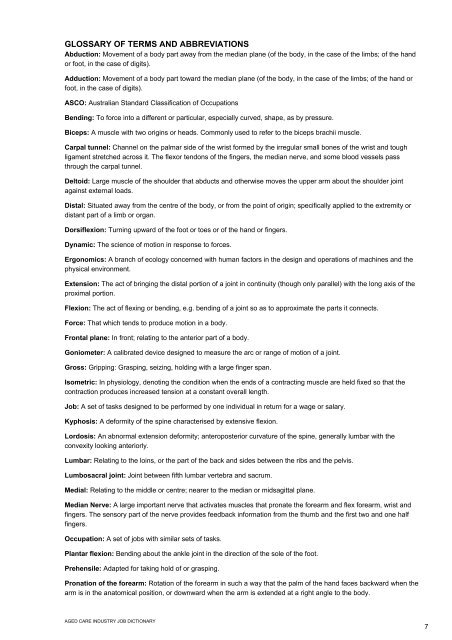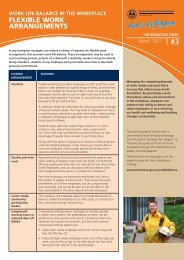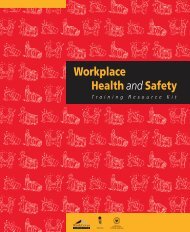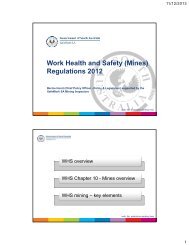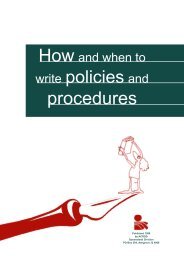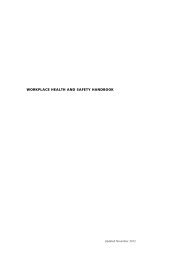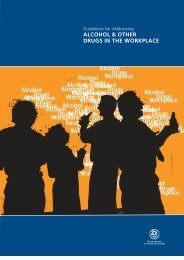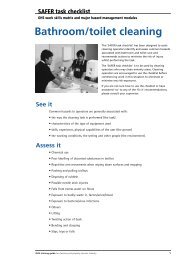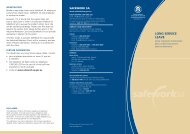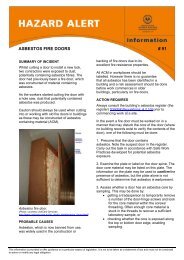aged care industry job dictionary - SafeWork SA - SA.Gov.au
aged care industry job dictionary - SafeWork SA - SA.Gov.au
aged care industry job dictionary - SafeWork SA - SA.Gov.au
Create successful ePaper yourself
Turn your PDF publications into a flip-book with our unique Google optimized e-Paper software.
GLOS<strong>SA</strong>RY OF TERMS AND ABBREVIATION<strong>SA</strong>bduction: Movement of a body part away from the median plane (of the body, in the case of the limbs; of the handor foot, in the case of digits).Adduction: Movement of a body part toward the median plane (of the body, in the case of the limbs; of the hand orfoot, in the case of digits).ASCO: Australian Standard Classification of OccupationsBending: To force into a different or particular, especially curved, shape, as by pressure.Biceps: A muscle with two origins or heads. Commonly used to refer to the biceps brachii muscle.Carpal tunnel: Channel on the palmar side of the wrist formed by the irregular small bones of the wrist and toughligament stretched across it. The flexor tendons of the fingers, the median nerve, and some blood vessels passthrough the carpal tunnel.Deltoid: Large muscle of the shoulder that abducts and otherwise moves the upper arm about the shoulder jointagainst external loads.Distal: Situated away from the centre of the body, or from the point of origin; specifically applied to the extremity ordistant part of a limb or organ.Dorsiflexion: Turning upward of the foot or toes or of the hand or fingers.Dynamic: The science of motion in response to forces.Ergonomics: A branch of ecology concerned with human factors in the design and operations of machines and thephysical environment.Extension: The act of bringing the distal portion of a joint in continuity (though only parallel) with the long axis of theproximal portion.Flexion: The act of flexing or bending, e.g. bending of a joint so as to approximate the parts it connects.Force: That which tends to produce motion in a body.Frontal plane: In front; relating to the anterior part of a body.Goniometer: A calibrated device designed to measure the arc or range of motion of a joint.Gross: Gripping: Grasping, seizing, holding with a large finger span.Isometric: In physiology, denoting the condition when the ends of a contracting muscle are held fixed so that thecontraction produces increased tension at a constant overall length.Job: A set of tasks designed to be performed by one individual in return for a wage or salary.Kyphosis: A deformity of the spine characterised by extensive flexion.Lordosis: An abnormal extension deformity; anteroposterior curvature of the spine, generally lumbar with theconvexity looking anteriorly.Lumbar: Relating to the loins, or the part of the back and sides between the ribs and the pelvis.Lumbosacral joint: Joint between fifth lumbar vertebra and sacrum.Medial: Relating to the middle or centre; nearer to the median or midsagittal plane.Median Nerve: A large important nerve that activates muscles that pronate the forearm and flex forearm, wrist andfingers. The sensory part of the nerve provides feedback information from the thumb and the first two and one halffingers.Occupation: A set of <strong>job</strong>s with similar sets of tasks.Plantar flexion: Bending about the ankle joint in the direction of the sole of the foot.Prehensile: Adapted for taking hold of or grasping.Pronation of the forearm: Rotation of the forearm in such a way that the palm of the hand faces backward when thearm is in the anatomical position, or downward when the arm is extended at a right angle to the body.AGED CARE INDUSTRY JOB DICTIONARY7


